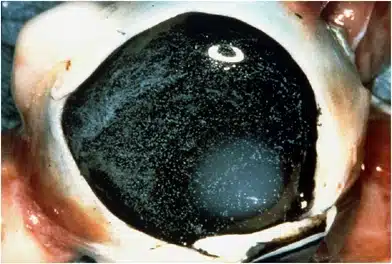The following statements are based on/translated from Kador & Wyman - statements at a Cambridge Symposium 2008 - on the original article:
Summary
Asteroid hyalosis (AH) is a common degenerative process in which fatty calcium globules accumulate in the vitreous humor. The condition rarely causes vision problems and surgical removal is rarely required. The presence of AH has been associated with systemic diseases such as diabetes; however, research in this area has been hampered by the lack of an animal model of AH.
Recently, we reported that AH occurs in galactose-fed beagles that develop the advanced stage of diabetes-like retinopathy. Comparisons of vitreous containing asteroid bodies (ABs) collected from these galactose-fed beagles with vitreous samples from age-matched normal beagles without ABs show that ABs contain calcium and phosphorus. Subtraction analysis of chloroform extracts of the vitreous samples by electrospray mass spectroscopy led to the identification of the quasimolecular ion of 1,2-dipalmitoyl-glycero-3-phosphoethanolamine (DPPE) as the main component of the ABs.
Because several reports suggest that ABs are composed of lipid-calcium complexes, we proposed that the major component of the ABs in the galactose-fed dogs with AH is a quasimolecular ion of DPPE, in which two molecules of DPPE are linked via their phosphate groups Calcium are complexed. We suspect that these lipid components diffuse into the vitreous humor from the degenerating retinas of these dogs.

(C) https://www.nature.com/articles/eye200835/figures/1
What is the asteroid Hylose?
Asteroid hyalosis (AH) is a common degenerative process in which fatty calcium globules accumulate in the vitreous body. Visual impairments are rarely the result of this disease and surgical removal is rarely necessary. The occurrence of AH has been associated with various systemic diseases, such as diabetes, retinitis pigmentosa, hypertension, hypercholesterolemia or lipidemia, and elevated serum calcium levels. Furthermore, active lipid metabolism was observed in the vitreous humor of Irish setters with hereditary rod-cone dysplasia (RCD).
How does she appear?
Although asteroid hyalosis is predominantly unilateral, it should be bilateral when associated with systemic diseases such as diabetes. This is because both eyes are equally exposed to hyperglycemia. Bilateral patterns of AH have been noted in diabetic patients.
Young male beagles 9 months or younger fed a 30% galactose diet for 42 months all developed AH.
The development of diabetes-like eye lesions was observed in 9-month-old beagles fed a 30% galactose diet. Symptoms include:
- Cataract formation
- Formation of pericyte ghosts
- Microaneurysms
- Spot and spot bleeding
- Confluent bleeding and non-perfused areas
- Asteroid hyalosis
- Intraretinal microvascular abnormalities
- Occluded arterioles
- Intravitreal hemorrhages
- Proliferative retinopathy
Pathogenesis
The pathogenesis of asteroid hyalosis is not yet fully understood. However, metabolic disorders, particularly those affecting lipid and calcium metabolism, are believed to play a central role. Therefore, there is an increased risk of AH occurring in patients with metabolic diseases such as diabetes mellitus.
Diagnosis of Asteroide Hylose
The diagnosis of asteroid hyalosis is usually made through an ophthalmological examination, during which the ophthalmologist can recognize the characteristic calcium globules in the vitreous humor of the affected eye. If necessary, optical coherence tomography (OCT) or an ultrasound scan may be performed to confirm the diagnosis and rule out other possible eye diseases.
Therapy of Asteroide Hylose
Treatment of asteroid hyalosis is conservative in most cases as the disease does not usually cause significant visual impairment. Surgical removal of the calcium globules may be necessary in rare cases if the visual impairment is significant or severely disabling. In such cases, a vitrectomy, i.e. the removal of the vitreous humor and thus the calcium globules, can be carried out.
Since asteroid hyalosis is often associated with systemic diseases, it is important to assess the general health of the affected patients and, if necessary, initiate appropriate measures to treat the underlying disease. This can include, for example, optimizing blood sugar control in diabetics or treating high blood pressure and hypercholesterolemia.
FAQs:
What is Asteroid Hyalosis and what are the symptoms associated with it?
Asteroid hyalosis (AH) is a degenerative condition in which fatty calcium globules accumulate in the vitreous humor of the eye. In most cases, AH does not cause significant vision problems and often goes unnoticed. However, in rare cases, vision impairment may occur.
How is asteroid hyalosis diagnosed and what treatment options are there?
The diagnosis of asteroid hyalosis is usually made through an ophthalmological examination, during which the ophthalmologist can recognize the characteristic calcium globules in the vitreous body. Additional tests such as optical coherence tomography (OCT) or ultrasound may be used to confirm the diagnosis. Because AH does not usually cause serious vision problems, treatment is usually conservative. In rare cases, surgical removal of the calcium globules via vitrectomy may be necessary.
Are there any risk factors or comorbidities associated with asteroid hyalosis?
Asteroid hyalosis has been associated with various systemic diseases such as: E.g. diabetes, retinitis pigmentosa, hypertension, hypercholesterolemia or lipidemia, and elevated serum calcium levels. Genetic factors and family history can also play a role. A thorough assessment of general health is important to identify and adequately treat possible comorbidities.
Summary
Overall, asteroid hyalosis is a widespread but mostly benign eye disease that rarely leads to visual impairment and usually does not require surgical intervention. Nevertheless, a careful assessment of the general health of affected patients is important in order to identify and adequately treat possible systemic diseases.
If you have any questions about the animal eye, please feel free to ask Ms. Veterinarian Kerstin Freigassner .
